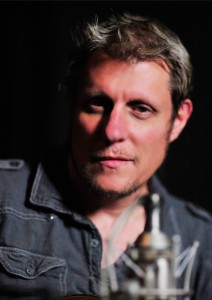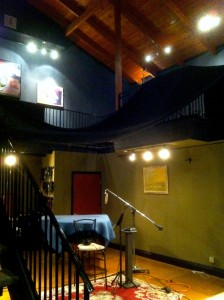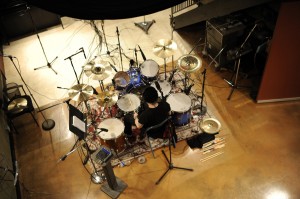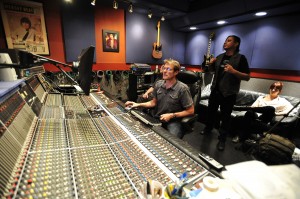The Mouse House: Lofty ‘Home Studio’ With A Big Sound
ALTADENA, CA: Monday morning at 11am is a great time to maneuver around L.A. The freeways leading in and out of the city are abnormally empty, rocketing me from downtown to Pasadena in under 20 minutes. From there it’s about another ten minutes straight up into the hills of Altadena.
The lights turn to stop signs and the hum of freeways and a bustling work week fade into a quiet street where no one would expect to find a world class recording studio. Cell phones struggle to get one bar, neighbors garden with straw sun hats and from the outside, The Mouse House looks like any other residential home. Once inside, your footsteps gently reverberate as your eyes adjust to a two-story-high live room filled with vintage music and audio gear. As you move around the house, it’s clear that this studio is a strategically planned culmination of years of hard work, patience, audio science and creativity.
On one of the few days of LA rainfall, back in 2000, engineer/producer Rich Mouser (Corrosion of Conformity, Spock’s Beard, Chris Cornell) headed up into the hills to take a look at a house for sale. He had recently moved his entire studio into his house, an awkward and highly temporary setup. His former studio was a rental and after ten happy years there, he received notice that he had one month to find a new place. After endless searches for commercial studio space, Rich was finding only overpriced and underwhelming spots.
So, he decided to look into buying a house and converting it into the ideal studio.
The main requirement was a really high ceiling.
DIY recording was already on the rise but Rich knew that people would always want a space to track drums, or for that matter anything that required a great open live room.
After asking his realtor for anything with high ceilings – quite literally, regardless of condition – the realtor remembered hearing of a really “weird, totally funky place” in bad condition.
As Rich walked in for the first time, a sea of buckets greeted him, doing their best to capture the falling rain in a near-condemned house. The walls were unfinished drywall, the floor cement. Weeds clung to scratch stucco on the outside. The previous owner passed away before he could finish, leaving the house abandoned and in an ever-increasing state of disrepair.
Standing under the cathedral style, 35-foot ceilings, Rich clapped his hands.
“I thought, oh my god, it’s like ‘When The Levee Breaks.’ If you want ‘When the Levee Breaks’ drums, this is the room for it. This is incredible. So I did the calculations on the spot…and thought, I really think I can make this place happen.”
With three days left in the auction, Rich put in his bid, and won.
DIY BUILD-OUT & UP
With a new mortgage and the task of not just converting but totally renovating, Rich didn’t have much left over for high price studio construction. A few companies bid on just building and treating the control room. With estimates between $80-$100K, he put his faith in his own abilities and set to work learning all he could about studio construction.
“I read a lot about sound proofing. And really luckily, I was at Rumbo Recorders doing a tape transfer and they happened to have a core sample of their wall. So I grabbed that and studied it – I pretty much totally copied the design of their wall.
“I did a lot of it myself, and with a crew from Home Depot. I found a couple of guys I could rely on. I would get up at 6 in the morning, go to Home Depot, get all these supplies, bring it up to the guys, get them going on the day’s task. Then I would go back to my house and record and then take a lunch break, drive back up here to check on them and then drive back to my house and keep working. That was the process for about 8 months to a year.”
And after two years, the studio was finished. The final product is a phenomenal sounding space complete with unique touches, like a cat walk encompassing the perimeter of the live room, at first only crossable via a 2×12 plank of wood. It’s now home to various pieces of gear, from amps to plate reverbs, Moogs and of course room mics. Even such small details as the paint used in the live room show tremendous attention to detail, a creative flare and a determined work ethic that is visible as well as audible.
“The walls are drywall but I used this textured paint that has sand in it. It gives it a rough texture so it’s not just totally flat. The floor is still concrete. The ceiling is tongue and groove wood at an angle – starts at 35 feet and drops down to about 25 feet.
“And there are so many weird angles in this room. Trying to sound proof it was a nightmare. There were all these windows that I had to cover up – with drywall and air spacing. I’d put drywall over the windows – three layers: drywall, soundboard, drywall. Then I’d put a 2×4 so there’d be air space of a couple of inches and then put another three layers of stuff on top of that. And some of those windows were up at the very top – 35ft high. So I’m in this scissor lift that only goes up to 25ft, on a ladder. I’m holding this piece of drywall up there, trying to screw it in thinking ‘Please don’t let there be an earthquake right now.’ Caulk, mud, stagger – and if you’re off by just a little, you have to go all the way down, move it over an inch then all the way back up.”
The only thing that Rich didn’t treat was the ceiling. When confronted with the idea of trying to soundproof the crown jewel of his studio, Rich decided to wait and see if the sonically open ceiling was a problem. After ten years, it isn’t.
ROOM, GEAR, VIBE, ROOM
Far from being a problem, in fact, the lofty ceilings of The Mouse House have lent their tone to many instruments, and artists, not just drums: Chris Cornell, Joe Holmes of Ozzy Osbourne, Josh Freese, Chris Vrenna, Robert Trujillo, Tears for Fears, Oleander, Spock’s Beard, Weezer and more.
“The room is great for acoustic guitar, strings, vocals, jazz recordings – I have a baby grand out there right now.
And I’ve made drum samples from that room. I’ll also put a PA system out into the room and put the drums back through that and then re-mic the room, along with adding samples; I’ll make samples of their drums and send them into the room as well, and maybe add my own. It comes out sounding like a completely different kit but still very natural.”
Potential uses for the live room are seemingly endless. The day I stopped by, there was an amp pointed at the wall up on the catwalk, and a curtain hanging the width of the room to slightly dampen the piano below.
Not to mention the amp room that’s filled with vintage Marshalls, Vox, Fender, Mesa and more. I noted a Fender Rhodes, Hammond, Mini Moog and Wurlitzer just on my first walk through. In various nooks and crannies, dozens of guitars, effects and microphones allow for even further sonic exploration. The mainstays, however, are the room mics.
“I have mics that are permanently set up pointed at the ceiling – old EV dynamics. I like using dynamics for room mics because it gives you that mid-upper mid. I don’t need it to be all crystal like a condenser, with the cymbals splashing all over. I even use 57s as room mics sometimes, pointing at the wall, capturing the reflections. But I will use 87s for room mics, facing the drums, to capture the cymbals.”
Outside of the permanent mics and priceless instruments, the remaining studio gear list for The Mouse House is extensive and varied.
He let go of his Allen & Heath board in favor of a Calrec UA 8000, 56 input, 32 bus console; one of 13 ever made, two of which were at Abbey Road and Polar Studios (ABBA). Local LA tech guru Pat Schneider brought it to his attention and helped him refurbish it after finding it sitting at Alpha studios barely passing signal.
Also from Alpha, he picked up his AKG BX 20 spring reverb, an EMT 240 and 140.
And for a producer/engineer who enjoys spending most of his time outside of the box, he makes frequent use of three different tape machines: an MCI JH-24 2” 24-track, an ATR-102 1/2” stereo and a Tascam ATR-60 1” 16-track.
“I definitely mix to the ½ inch, almost all the time. Unless it’s some kind of dance/electronic thing, but with rock stuff, definitely hit the 102. I really like the sound of it. All those spikes you get in Pro Tools, it goes completely away when you hit tape.”
He originally didn’t even want to get a Pro Tools rig but when Weezer called, they sent Pro Tools files instead of tape. Years down the line, he’s found a workflow that utilizes the ease of digital with the sound of analog.
“I’ll use the onboard EQ and outboard gear for general sounds and tracking but when there’s fine-tuning to do, I’ll use plugins and automation. There’s no automation on the board – so all the volume rides are done in Pro Tools. And what I’ll do is print a lot of outboard effects, like the Cooper time cube or the plate reverb, back into Pro Tools. So I don’t have to use a bunch of auxes and buses, or leave the Echoplex running throughout the whole mix. I print it in and then I can play with those analog effects inside Pro Tools.”
This co-existence of analog and digital seems to be the industry standard these days. Seven years ago, I didn’t know how to align a tape machine, and that was okay. Now, I align 3-4 tape machines a week at The Village. Private studios are up on this trend as well, incorporating tape into their workflow and gear lists. You find more and more musicians and producers taking advantage of both the stripped-down digital systems in their own home studios as well as the tape, analog gear and know-how of a professional studio.
To stay relevant and stay employed, engineers and producers have to change with the trajectory of the industry, and Rich Mouser has done just that.
The Mouse House embodies the combination of a pro studio and the homey atmosphere of a house in the hills, with a pool, bedroom and even a guitar body toilet seat. The sounds are there. The gear is there. The vibe is there. Bring your ideas.
Visit The Mouse House at http://www.themousehousestudio.com.
Eleanor Goldfield is a Los Angeles-based writer, musician and studio tech. She is lead singer in the hard rock band, Rooftop Revolutionaries, and chief tech at The Village Studios.
Please note: When you buy products through links on this page, we may earn an affiliate commission.











Nancy Jones
January 9, 2014 at 3:12 pm (11 years ago)Nice story of finding your “dream” place and making it your dream. My son Troy. is there now recording with his band, “White Minorities”. I hope all the guys in the band are having fun and that their recording becomes a big hit!